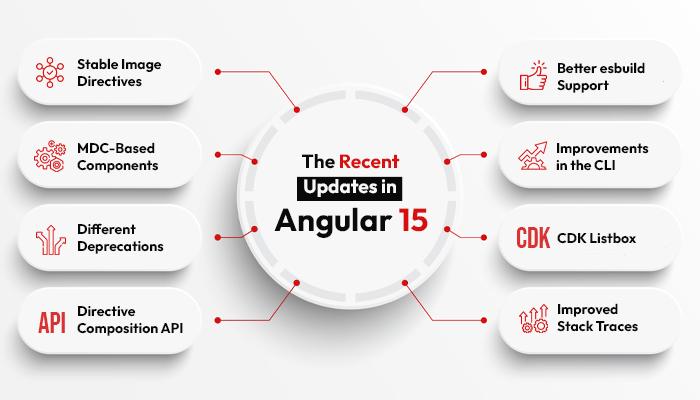
Angular, one of the highly sought-after, open-source frameworks, released its version Angular 15, on 16th November 2022. When the earlier version, Angular 14 was more focused on experimental features, this version is getting popular for its stability. An AngularJS application uses HTML, CSS, and JavaScript to develop client-side applications. Developers can build applications faster and more efficiently with AngularJS using HTML extensions rather than traditional JavaScript frameworks like jQuery. Check out more exciting details about this latest stable version of Angular from the following segment of this blog.
Take a Look at The Best Features of Angular 15
Several new features have been added to Angular development version 15, such as the ability to build multi-route applications using a variety of stand-alone APIs. In addition, it also allows the bundle size to be reduced since unnecessary features from the router are removed during the build. Some of the best features are-
- Stable Image Directives
In Angular 14, we found The NgOptimizedImage, which helped a lot in improving the loading image performance. Now, it has managed to achieve a stable form in this version. According to the recent study done by Land’s End, this feature brought a notable improvement in LCP ( Largest Contentful Paint) image loading. NgOptimizedImage in the previous version also experienced many changes. But it was not as exciting as Angular 15.
The two best features that need a mention here are Automatic srcset Generation and Fill mode ( it is now in the experimental state). Automatic srcset Generation uploads the accurate image as per request for image downtime. While using the Fill mode, you don’t need to declare the image dimensions. This mode creates an added convenience for unknown image dimensions. The NgOptimizedImage directive is usable in the Angular component.
- MDC-Based Components
In Angular 14, refactoring the component-based Angular material was a big challenge. Thankfully, it’s not the case for Angular 15. Refactoring is easier here for MDC or Material Design Components for Web. In this version, you will find the older application of the components from the legacy import. Changes in MDC enable Angular to reuse codes and closer alignment to the material design specifications. For many components, there were updates in styles and other things were rewritten from scratch.
- Different Deprecations
Moving towards simplicity is the goal of every new release of Angular development, and Angular 15 is also the same. However, in different studies, the presence of some misused or rarely used patterns was there. As a result, developers focused on deprecating provided: ‘any’ with limited usage. Besides it, there was a deprecation in providedIn: NgModule also.
Most times inappropriate usage was found in many conditions and these situations, developers prefer to use providedIn: ‘root’
Using the emerging layouts in the CSS, there will be no publishing of the new releases of @angular/flex-layout
- Directive Composition API
The latest stable version of Angular 15 implemented the Directive composition API successfully. Code reusability becomes possible here. Also, you can use it to increase the number of host elements that have directories. Build Angular apps by using this feature to bring efficiency to the development process.
- Better esbuild Support
In Angular 14 also, ng build was there that offered quicker builder time and pipeline simplification. In this current version save as SVG template serves this purpose, and ng build-watch support is also there.

- Improvements in the CLI
Standalone stable APIs were there in an Angular CLI and in Angular 15 developers have the option to generate a standalone component by using ng g component –standalone.
Besides, in the new version, developers focused on simplifying the new output. Initially, you can lessen the configuration by obliterating the three sections, including test.ts, polyfills.ts, and environments.
If you want to lessen the configuration overhead later use .browserlist and define the target ECMAScript version.
- CDK Listbox
The prime aim of the CDK ( component dev kit) list box is to deliver different behavior primitives and to create several UI components. Customization of the list box interactions in Angular 15 becomes easier due to the CDK list box.
- Improved Stack Traces
Angular application debugging was a big deal. But after the introduction of Angular15, the scenario has changed. These updates created convenience for developers by offering a simplified debugging process. Now Angular developers can trace development codes easily. The earlier Angular versions delivered a one-liner error message to developers that often made the bug resolving a complex and lengthy process.
But in this version, after lots of research and collaboration with the Chrome and Angular developers team, third-party dependencies were integrated that provide the linked stack traces.
Some Added Updates;
- Improvement in Language Features
Language service in Angular 15 also needs a mention. It enables developers to write code confidently. Using language features for automatic component import is also a good idea.
- Auto-Unwarps Default Exports
Simplifying the router functions is also possible in Angular 15. The router over there will try to find the default export, and after finding it successfully, the lazy files will get imported into the code.
Final Lines
Angular’s developers did an excellent job providing the Angular 15 version since many developers asked for some unique features. Among the most unique features of this version are those provided by the development team. However, if you also want to leverage the amazing potential of this technology, hire trusted developers from a leading angular development company now. They will help you to get the required development solutions that will help you to make the best use of this technology.
 +44 141 628 8980
+44 141 628 8980
 (786) 269-2247
(786) 269-2247
 +61 872007153
+61 872007153
 +91 8900027268 (Sales only)
+91 8900027268 (Sales only)








